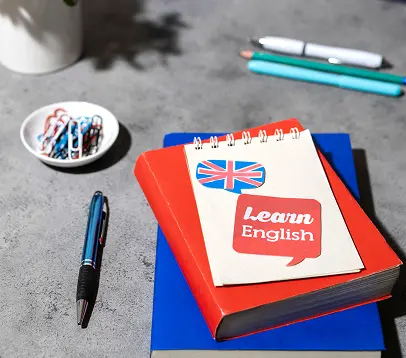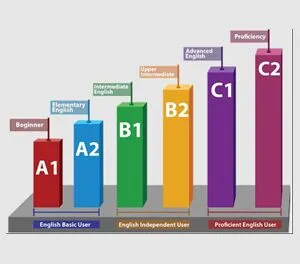- General English
- Business English
- Kids Tutor
- Pronunciation
Improve your grammar, vocabulary, and fluency for real-world communication.
Searching for the best English classes? Our spoken English courses are taught by British and American tutors and provide the student with the perfect learning environment to improve their English conversation and writing skills. We also provide private tutors for home-based or online general English courses.
For students who want private speaking lessons to improve more quickly and study at flexible timings, we have a selection of native English tutors to choose from. Here, our native teachers will tailor the course to your needs, moving at the best speed for the individual learner. This is particularly helpful for students who need English writing coaching or an English speaking course.
Semi-private English lessons are also an option if you have a small group of friends or colleagues who want to study in the same group.
Our team of English tutors make lessons fun and are committed to helping students to speak English quickly! Our small group general or spoken English classes are taught by British or American teachers to give students the best chance to improve their pronunciation. For our english speaking courses in Dubai, we use the latest Oxford University English materials and interactive technology to make our English courses effective and fun.


communicative approach, which means that the focus is on practicing and improving the student’s communicative skills in realistic, interactive situations. This methodology means you will experience real improvement in our English classes. It also means the lessons should be fun with quizzes, e-learning apps and interactive displays to enhance your learning experience.
Each level also has a vocabulary section which we practice together using the latest quiz games on our interactive whiteboards. The Express English learning program combines the latest technology with fun, active teachers to bring you the results you need!
We use the latest Cambridge University materials to make our English tutoring relevant to students living and working in the modern world.
To keep our students happy, we use British and American tutors to help them get used to the same accents and work on their English pronunciation.
Where are our teachers from? Key to building a great Spoken English language institute is listening to our students and many of our students want teachers with British or American accents. Most of the tutors currently teaching at Express English language institute are British or American.








Our standard rate for an English class with a British teacher is 975 AED per 20-hour course, but if you call or come and speak to us at the center, we can tell you about our amazing promotions for booking multiple levels.
In addition to spoken english classes, we are providing writing coaching with one of our expert British or American tutors.
Your private English teacher should focus on conversation practice, pronunciation, English grammar, and expanding your vocabulary. Also, as private English lessons are tailored to the student’s needs, you might want to request help with accent reduction, learning useful phrases, and expanding your vocabulary.
We believe that the best English lessons combine fun, interactive granite got the other thanks classes, British and American English teachers, and the latest spoken English course materials and educational technology is a good recipe for the best English language training course.
Our general or spoken English courses teach students English listening, reading, writing, and speaking skills to become fluent in all areas quickly but the main focus is on improving speaking. Each spoken English class will also focus on English conversation, pronunciation, grammar, or vocabulary and all these skills are important to become fluent.
Yes, at Express English institute, we provide KHDA accredited certificates for each course
Our staff are trained to design flexible courses to fit your schedule. Just give one of our team a call to find out more!
Many students don’t enjoy English grammar lessons, grammar study is an important part of becoming fluent in the language. We teach using the communicative method, so grammar is taught inductively without long tiresome grammar sessions.
Yes, we are happy to arrange one-to-one English lessons with a private English tutor. We advise taking these lessons at our centre, but there is also the option for home-based private English lessons.
If you want to improve your English emails, you should join our business English courses in Dubai. However, if you need report writing or academic writing we can provide a private English teacher with experience in teaching essay writing, advanced grammar, paragraph structure, and academic vocabulary.
If you want to learn English, call or visit our English centre in Dubai. Please click this link to see our branches.
Watch or listen to English radio, TV, Netflix or news shows.
Practice English speaking every single day.
Read English newspapers, blogs and web feeds.
Don’t worry about making mistakes in English grammar – just keep practicing!
Find a good spoken English course.
Use an app like Quizlet or a Notepad to record new English vocabulary.
Keep practicing your writing by sending frequent emails, writing blog posts, a journal or as part of a course.
Use a spelling and grammar checking app like Grammarly.
Find a good English writing course with highly qualified teachers who are used to teaching advanced grammar and essay/email writing.
Get an English tutor to give you feedback on your emails.
Yes, IELTS preparation course is mainly designed to improve your exam strategy and technique. This will be enough to help many students reach their target score. However, some students will need to improve their English level, and general English classes are the best way to achieve this.
Candidates will sit a progress test at the end of each level, so they can see exactly how much their English has improved.
Most students notice progress in the first month of their English language course, but to see a really significant jump you should probably study for 2 to 4 months.
Duration: 22 Hours
General English courses at Express English use the communicative method to ensure students have the skills they need to make themselves heard in the real world. We use the latest materials and technology to ensure that the lessons are interactive, informative, and fun.
Native speaker instructors and the latest materials mean students learn the correct and most appropriate forms of the language. Web applications and interactive whiteboard technology inject fun and help our teachers provide language courses which stand out as different from the competition.
Duration: 22 Hours
Our General English courses are taught by highly experienced native speakers, and include effective exam strategies to help our students get the best results possible. We use our interactive white boards to let students practice the questions just as they would in the real exam.
Courses include the following benefits:
I’m really glad I chose this training center for my IELTS practice.6 weeks of training, I got my desired IELTS result.Our instructor Mr. John tells you where exactly you need to improve.Never got bored while in his class, I really had fun while learning.
Thank you very much. I do recommend Express English Language Training Center.

Student
Since I’ve joined, I feel so motivated to learn English from the best teachers in the best school with the best facilities. I have been studying for more than 1 year and can say I am in love with the school and really appreciate their care, professionalism and quality of service.

Student
As the name suggests Express English it’s really one of the best institute if you would want to have an Express English learning.
John the lead professor is a very professional teacher that I have come across who has tailored the classes based on the student’s needs and ensures that the class is always live.

Student
Excellent customer service and exceptional teachers. Loads of review materials, brilliant tips, and outstanding teaching methods. I was only aiming for band 7 but I got a band score of 8! Truly overwhelmed and grateful for this institute. Highly recommended.

Student
All the teachers here are very helpful and all of them are native which helps with the accent too. The classes are not only informative, but also a lot of fun and exciting.

Student
